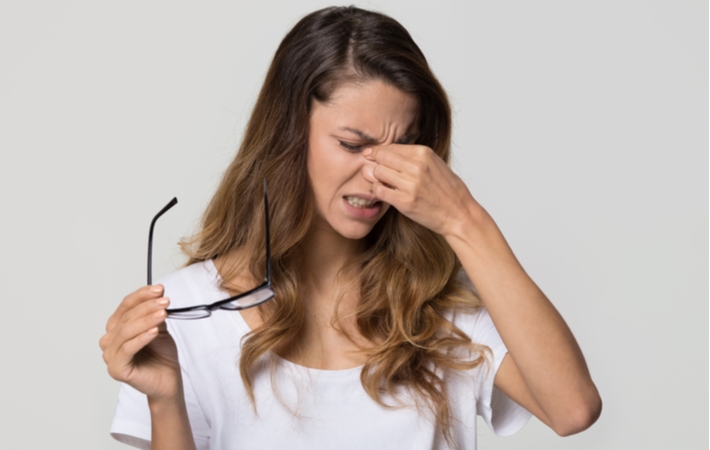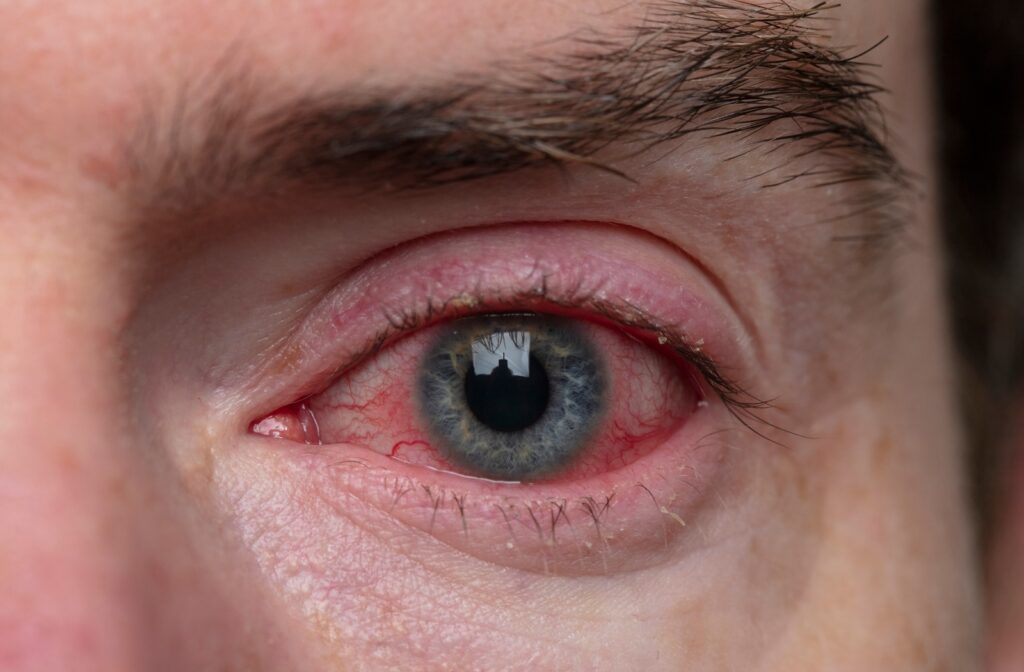Chronic Dry Eye & Blepharitis
Vision is closely intertwined with eye health. When you feel eye discomfort, it can affect how your vision functions. Chronic dry eye can distract from your day and lead to vision problems. Dry eye therapy can help, but the first step is learning what’s causing your eye problems.
Blepharitis and dry are both considered eye diseases, and they share similar symptoms. But are these eye conditions the same?
What Is Blepharitis?
Blepharitis is an inflammatory eye disorder where dandruff-like scales form on the eyelashes. The crusty flakes can cause eyelashes to stick together and trigger the urge to rub the eyes. Increased eye touching and rubbing can further irritate the eye and lead to a secondary eye infection.
Common symptoms include:
- Burning or gritty eyes
- Cornea inflammation
- Dry eyes
- Eyelid swelling
- Eye irritation or itchiness
- Missing or misdirected eyelashes
- Teary eyes
Blepharitis is a common condition caused by bacteria or a skin condition. There are 2 types:
- Anterior blepharitis occurs at the outer, front edge of the eyelid where the eyelashes attach.
- Posterior blepharitis affects the inner edge of the eyelid, closest to the eyeball.
What Causes Blepharitis?
Anterior blepharitis is more commonly caused by bacteria, but allergies or a mite infestation can also cause the condition. Posterior blepharitis can occur when oil glands in the eyelids don’t function effectively; meibomian gland dysfunction (MGD) can cause meibomian blepharitis.
Both blepharitis types can develop due to skin conditions, such as dandruff (falling from the scalp or eyebrows) or rosacea.

Causes of Dry Eye
Although dry eyes are a symptom of blepharitis, it isn’t the only cause of dry eye. Dry eye is a chronic condition caused by a lack of tears or poor quality tears. Blepharitis can interfere with the eye’s ability to produce tears or clog glands that produce tear components (meibomian blepharitis).
Tears are made of 3 layers: the oily outer layer, the watery middle layer, and the inner mucus layer. These layers (the tear film) protect and nourish the eye. When a health condition or environment affects part of the tear film, it can cause tears to evaporate too quickly or limit how much nourishment can reach the eye’s surface.
Dry eye can be caused by:
- Aging
- Medications
- Medical conditions
- Environmental conditions
- Eye surgery (LASIK, cataract surgery)
Temporary dry eye, such as exposure to smoke or wind, usually doesn’t harm the eyes long-term. However, dry eye disease is a chronic condition. Untreated, dry eye can cause eye surface damage and vision impairment.
Common symptoms of dry eye include:
- Blurry vision
- Burning or stinging eyes
- Feeling something in the eye
- Gritty or scratchy eyes
- Light sensitivity
- Stringy mucus
- Redness
- Watery eyes
The Link Between Blepharitis & Dry Eye
Blepharitis and dry eye disease are not the same condition, but there is a link. The overlap of symptoms often complicates treatment; however, treating one usually improves the outcomes for the other.
Dry eye and blepharitis typically occur together when there is a tear evaporation issue. As a result, meibomian gland dysfunction can also be intertwined. When oil glands (meibomian glands) are clogged or don’t produce meibum (oil) effectively, it can cause dry eye disease and blepharitis.
The majority of dry eye problems are related to inefficient oil gland production. So, it’s no surprise that blepharitis, dry eye, and MGD tend to develop together. But what about dry eye caused by too few tears? Is blepharitis still common?
The lacrimal gland, which produces the aqueous (watery) layer of tears, is located underneath the upper eyelid inside the eye socket. Lacrimal gland production can be affected by various conditions, including injury to the eye. Aqueous tear deficiency accounts for 10% of dry eye cases.
Although aqueous tear deficiency is less common as a sole cause, it is a common component found in patients with blepharitis.
Treating Blepharitis & Dry Eye
Treatment for blepharitis depends on the type, and treatment for dry eye depends on the cause. When blepharitis and dry eye occur together, treating blepharitis can improve dry eye symptoms.
The main focus of treating blepharitis is eyelid hygiene. Keeping the eyelids and eyelashes clear of crusty buildup and washing excess bacteria can alleviate symptoms. Applying warm compresses can loosen the dandruff-like flakes and help unclog oil glands.
Patients with blepharitis should gently scrub their eyelids (using baby shampoo or a gentle cleaning product recommended by their eye doctor). Carefully massaging the eyelids can also help loosen oil accumulated in the meibomian glands.
When blepharitis is caused or aggravated by a bacterial infection, your optometrist may prescribe an antibiotic medication.
Visit Us for Dry Eye Treatment
Our experienced doctors at CHROMA modern Eyewear Eyecare are dedicated and educated on how to treat dry eye disease as no two patients are alike. Our doctors can take the time to understand your condition and decide which treatment is best for you. Even if an alternative such as Autologous Blood Serum Drops or an Amniotic Membrane is needed to replenish the cornea back to a healthy state.
So when dry eye or blepharitis is causing eye discomfort, visit us in Fort Worth. We also welcome you to our questionnaire to see if your symptoms might be dry eye. We care about our eye health and want to make your experience as comfortable as possible. Book an appointment today to find relief for your dry eyes.



